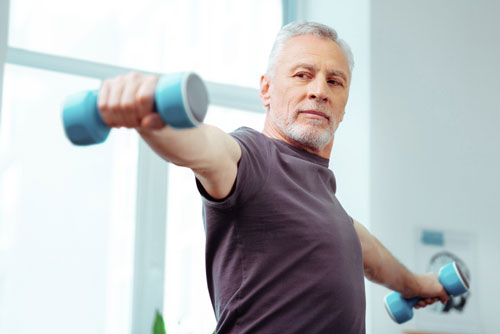Scientists call it the “Goldilocks Zone.”
As you might expect, it originated with the old tale of Goldilocks and the Three Bears.
It’s when a dose of something is effective not when it’s too small or when it’s too large…but when it’s just right.
So it is with exercise.
Researchers have found that during outbreaks of viral diseases such as coronavirus, not exercising is harmful. And so is exercising too much.
Somewhere in the middle is just right for optimal immunity.
A study published in the journal PLOS One looked at the Hong Kong flu outbreak of 1998. Researchers found that people who did no exercise or worked out more than five days a week had the highest risk of dying.
Those who exercised moderately had the lowest risk.[1]
Animal studies have backed up those results. Research published in The Journal of Infectious Diseases divided mice into three groups. One group did no exercise. The second did one session of hard exercise. The third did regular exercise, five days a week.
After three months, scientists infected the mice with a flu strain. The regular-exercise rodents didn’t get as sick as the others. Their lungs were less infected and they lost less weight.[2]
Another study from the journal Brain, Behavior, and Immunity found that, among flu-infected mice:[3]
- 43% of the sedentary survived.
- 30% of strenuous exercisers survived.
- 82% of moderate, 20-to-30-minutes-a-day exercisers survived.
Other human studies have had similar results. A study from the University of South Carolina found strenuous exercise was associated with higher risk of upper respiratory tract infection. Moderate exercise was linked with a reduced risk.[4]
We should note that you should exercise before you get sick. If you get coronavirus, you should rest. Exercising while seriously ill increases your risk for complications.[5]
5 Exercises to Do While Social Distancing
Sessions of 20 to 40 minutes, three times a week is the exercise Goldilocks Zone.
Here are five exercises you can do while social isolating. You want to do a mix of strength and aerobic movements. They equal a good all-around workout.
- Running in place. If you don’t have a treadmill, this will do just fine. If it feels too easy, raise your knees a bit higher. Jumping rope is another aerobic option.
- Pushups. Pushups are more than an arm-strength workout. Each repetition forces you to use your shoulders, parts of your back, and even your abs to help stabilize and support your weight. Pushups are the foundation for total, functional upper-body strength.
- Squats. Think of these as pushups for your lower body. Squats lead to the kind of strength you’ll feel every time you climb a flight of stairs or get up from your seat after dinner.
- Planking. A better alternative to sit-ups. Planking activates more muscles. That’s because during a plank, you’re using your abs, back muscles, hips, and glutes to help stabilize your body. Unlike a crunch or sit-up, planks help build complete core strength—not just nice abs. And they’re easy to do: Get into the pushup position, but rest your elbows on the ground. Keep your stomach off the ground and try to keep your body straight. Hold that position for 20 seconds or as long as you can. Rest and repeat.
- Bicycling. Great for your legs and your heart. Make sure to take a route that isn’t crowded…like an isolated bike trail or neighborhood streets.
It’s more important than ever to exercise inside the Goldilocks Zone to keep your immune system at its peak.
Editor’s Note: Discover “infinite immunity.” A Nobel Prize-winning scientist uncovered a way to give your body the power to fight off virtually any infection. Find out more by reading our monthly journal, Independent Healing. Go HERE.
Related Articles
Coronavirus: One Vitamin May Be the Key to Stopping It
Coronavirus: 8 Dos and Don’ts for Social Distancing
7 Coronavirus Myths You Shouldn’t Fall For
Like this Article? Forward this article here or Share on Facebook.
[1]https://journals.plos.org/plosone/article?id=10.1371/journal.pone.0002108
[2]https://academic.oup.com/jid/article/200/9/1434/851906
[3]https://www.sciencedirect.com/science/article/pii/S088915910500067X?via%3Dihub
[4]https://www.sciencedirect.com/science/article/pii/S0889159108002936?via%3Dihub
[5]https://bjsm.bmj.com/content/43/9/722

